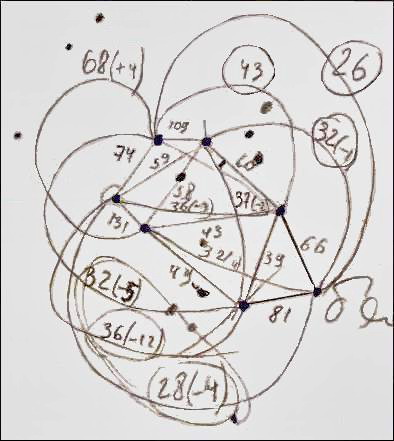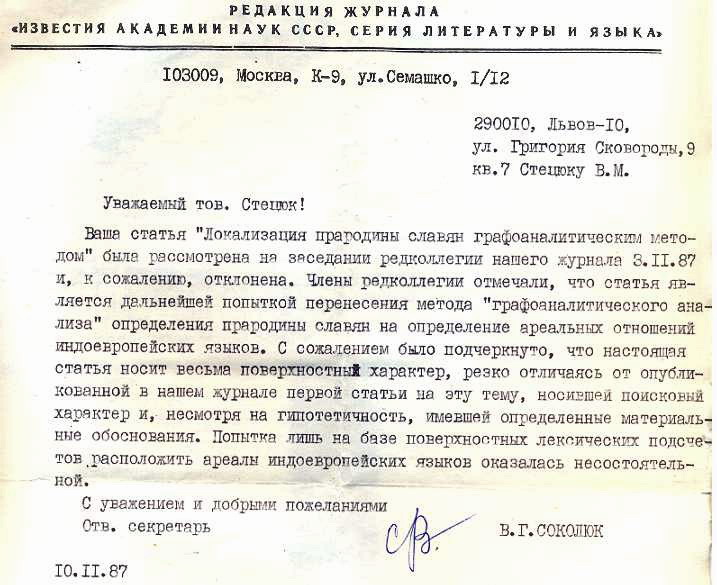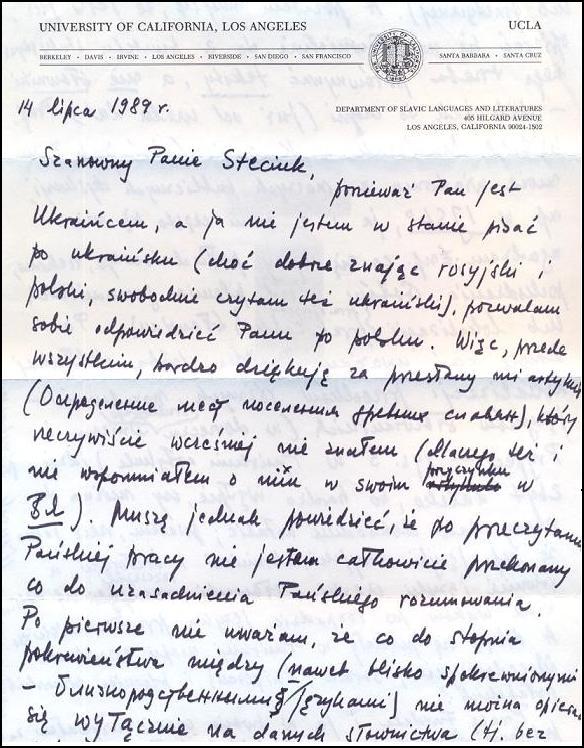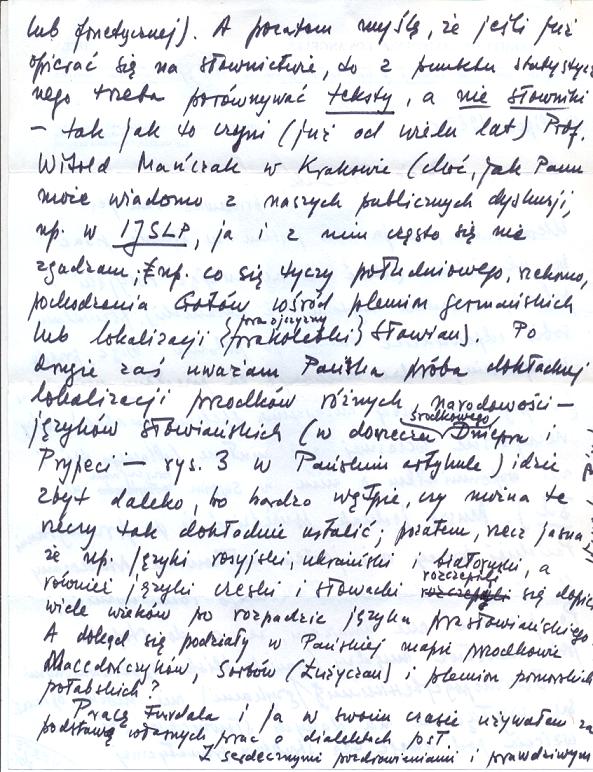An Independent Reseacher' s Trying Experience History
Since the recognition of my work in the coming years (and maybe even decades) is not expected. Yet, most of the research results are increasingly supported by both linguistic and extralinguistic means. The inevitability of their recognition once becomes apparent, then the question certainly arises why it happened so late. I can assume that the academic establishment, to avoid accusations of myopia and retrograde, put all the blame on me as allegedly not showing enough perseverance in popularization my work, or the inability to persuade influential people in science on the right.
Thus, historical justice requires the author to present the efforts that he put into trying to convince scientists both in Ukraine and in other countries for future generations. With this feature, we can simultaneously touch on the process of research in chronological order. This, to some extent, may also explain why the investigation took so long to be recognized.
The impetus for the large-scale study was the discovery of the relation between the number of common words in related languages and the distance between the areas where these languages began to form. This discovery took place over several years, I never planned to engage in linguistic studies seriously. Just out of curiosity, customary when studying some Slavic languages, I set for myself a question: which of them are most similar to each other? Thus, at once was the spatial mapping of their relationship. It only remained to find some sign, which in the absence of specific knowledge was selected from many common words. However, the question arose – what words do we need to take? Solving this question, I started to get acquainted with the basics of comparative linguistics. First, about 400 Russian words that have been identified as having a decidedly Slavic origin were chosen from some source. According to their semantics in this list, the words of the seven Slavic languages are listed. How many words in the list I can not remember now, because it is not in my archive. Matches from other languages have been added for each word in the list, and thus there was a matrix or table where the alleged Slavic roots of words were set in a vertical column, and their matches from different languages were in a horizontal column.
Then, using this table, the number of common words was estimated in language pairs, but the comparison of their number did not give promising results, since they did not differ significantly and obviously could be in the range of statistical error. Therefore, the grounds for any reliable conclusions were absent, and the idea was rejected, but not forgotten. This was the year 1976. After a while, maybe even a year or more, I returned to the idea, and suddenly realized that the degree of relatedness is hidden by words being common to all seven languages. If they are rejected, then the relationship can be manifested more clearly. Here to tell my college education. When presenting a non-sinusoidal, but periodic electric current in the form of an infinite harmonic Fourier series constant component stands out, to which are added the trigonometric functions of multiple frequencies. Something like this was seen by me at comparing the number of common words.
When I removed all common words from the list, only 153 roots remained with their matches in different languages. Again, it was estimated that the number of common words in pairs of languages and the degree of their proximity to each other are presented more clearly. Based on these results, a first graphical model of the kinship of Slavic languages was built, and it is represented in the figure below.

The scheme was based only on the number of words in the most related languages according to the calculations. Having taken note of the result, I'm a long time did not take the next steps in the experiments, not seeing them as anything special. However, in April 1983, I again reviewed the scheme and, for some reason, measured the distance between a pair of distant languages and counted it in the corresponding number of common words in this pair. Surprisingly, it coincides with their actual amount. Shaken up, I began to measure distances between all languages and translate them into the number of common words. Almost always, the distance is more or less exactly with the results of calculated. Then I realized that the number of common words in pairs of related languages is inversely proportional to the distance between the areas where each of these languages began to form.
Inspired by this idea, for about six months I was compiling on the basis of bilingual dictionaries a table of already eight Slavic languages, adding to Polish, Belarusian, Russian, Czech, Slovak, Ukrainian, Serbo-Croatian, and Bulgarian, which I considered earlier, also the Slovenian language. Re-count allowed to get a graphical model of kinship, which was similar to the one made prior. Since there is a clear relationship between the distance and the number of words, it has become clear that the model reflects the location of the areas of the individual Slavic languages at their formation. Knowing already on the literature of testimony of ancient historians who divided all the Slavs into two large groups, the boundary between the settlements of which was allegedly the Dniester River, I assumed that the boundaries between the first Slavic areas should be the river. Such areas are not found either in the basin of the Dniester or in the catchment of the Lower Dnieper, where I assumed the location of the common Slavic territory. So the search was moved further north and here the resulting model can be placed in the middle basin of the Dnieper, where its tributaries form a branched network of real limited areas. When the location of the settlements of the Slavs was confirmed by already known results of other studies, I became convinced of the effectiveness of the inventive method. In this case, it had to be somehow called. Nothing better as definition "graphic-analytical" occurred.
Realizing the importance of linguistics and history as the applicated procedure and the obtained results by it, I described my idea and results in order to pass all these in academia. More competent of my friends advised me to turn to the historian G.G. Litavrin at the Institute of Slavic and Balkan. I met him at the beginning of December 1984. He heard with great interest my report and I was expecting that he would get to know with my results Slavists dealing with the problem of the ancestral home of the Slavs, believing that my mission is over by this, and the results and the method would be used by specialists. But I was wrong. Litavrin advised me to go to linguists and archaeologists, and to acquaint them with my work, allowing for the connection of some phone numbers. However, he warned me that linguists are generally very skeptical of the research of amateurs. I did not pay much attention to this warning and, although surprised by his indifference, do not lose hope to interest other scientists and began to establish contacts with them.
Thus began my "ordeal", but I did not think that it will extend over decades. In Moscow, I met with almost all leading linguists, and contact with them gave me a lot of useful information, especially in this respect, it should be noted NI Tolstoy (1923 – 1996), who invited me periodically on various linguistic activities – workshops or conferences. But in general, my results were seen with suspicion, and O.N. Trubachiov (1930-2002) treated them with abhorrence and hinted at my dilettantism. Besides them, I spoke with V.V. Ivanov, V.N. Toporov (1928 – 2005), Ju.N. Karaulov. For the latter, it was not his area, Toporov was sick and busy with his work with the dictionary of the Prussian language, and Ivanov allegedly interested in my method, but quite tactless refused me in a meeting for a more detailed discussion. After that, I met with the archaeologist Slavic V.V. Sedov (1924 – 2004). Intrigued by my results, he asked me, if I can place the model in another place, as I understood to confirm the location of the Slavic ancestral homeland in his version. I replied that this would be impossible, and he immediately lost interest, but, nevertheless, told me that similar results were obtained by V.T. Kolomietc (1922 – 1993), a linguist-woman from Kyiv, and promised to find me her phone number. The promise he made in a few days and at the same time advised me to use my method not on my own data but on the materials of etymological dictionaries of Slavic languages, one of which was published with the edition of Trubachiov, and the second was edited by Polish scientist F. Slavsky (1916 – 2001). I immediately set about drawing up a new table on the recommended data and at the end of this work the third model was built and it was similar to the first two. When this work was finished in August 1984, I went on a weekend in Kyiv, where I was able to meet with Vera Kolomuiets. After a long conversation with the discussion about my method and the results, she told me that my work is already finished doctor's dissertation and that she is ready to become my supervisor. Having her plan of the future dissertation I returned to Moscow to begin serious work. Just at that time I was finishing service in the Soviet Army and had the opportunity to work quietly at home and in the libraries of Moscow. I bought a typewriter and typed the text and table-dictionary at home.
In December of the same year Trubachyov published his article "Linguistics Certificates" in the communistic official newspaper "Pravda", which among other things criticized as an attempt by some linguists to place the original homeland of the Slavs somewhere "in the swamps". I understood this statement as a hint also on my work, because I saw that he did not like as my method and received by means of its results, according to which the settlement of the Slavs occupied the wetlands of the Pripyat basin. Later, at our meeting in Kyiv at the congress of Slavic archeology, he looked at me with such hostility that I did not even dare to talk to him more. However, the talk was about, because I just finished my "dissertation" and my chief has disappointed me at this time, saying that I would not be allowed to defend my thesis, since I have no special education and candidate examinations are irrelevant for help. At the same congress, I spoke with the Belarusian archaeologist L.D. Pobol (1924 – 2004). He agreed to read my work, but after reading explained to me that such things have to write scientists having the same name in science, and advised me to take the topic easier. Similarly, I was not able to interest also Polish archaeologists, but they advised me to apply to Hanna Popowska-Taborska in Warsaw. I did meet her, but much later, but at that time I was in a confused state of a few. Fortunately, Vera Kolomiets said at our meeting her husband A.S. Melnychuk (1921 – 1997) is a member of the editorial board of the journal "Proceedings of the Academy of Sciences of the USSR. A series of literature and language," and promised me to persuade him to publish an article in this magazine. She succeeded that because she was interested in publishing too. I was preparing an article for almost a year, several times righting the text that is sent to Melnychuk for viewing and he looked through it very carefully. With the finished article, I went to Moscow where gave the necessary explanations for the edition and even paid for making maps. Finally, the article was published in the first issue in 1987. The article was very much for workers of the edition because they published nothing similar before, and I agreed with the editor V.N. Yartseva (1906 – 1999) on future publications, as I have already identified the ancestral home of Indo-Europeans. I asked her whether it is necessary to find a reviewer, but she replied that they already know me as the author, so the reviewer is not needed. However, it requested to send the article later because the next room getting ready for the 70th anniversary of the October Revolution.
But it did not happen as expected. The fact is that my work indirectly implied that any Old Russian or otherwise Eastern Slavic language did not exist, and the Russian, Belarusian, and Ukrainian languages evolved from primary dialects approximately simultaneously with the other Slavic languages. This was contrary to the prevailing doctrine of the Soviet Union, according to which the population of Kievan Rus used one common language, which from evolved Ukrainian, Russian, and Belarusian. Obviously, Yartseva, agreeing to cooperate with me, this nuance overlooked or under his rather advanced age decided to publish "sedition". But I knew that Trubachyov quickly caught Trubachov that while our conversations and surely this implies his dislike to me. He was an officious scientist and this is confirmed by his numerous publications in "Pravda". I am sure that he would not allow the publication of my article if I knew that it was ready to print. This assumption is supported not only by his fantastic ideas that have now become a source of mythmaking Russian nationalists but also by the fact that copies of the magazine with my article were immediately removed from the reading rooms of libraries. Ask about it in the Lenin-Library, I was told that this magazine is in storage, but you can order it. I realized that this was done in order to know as little as possible readers and such description could be given by some influential person.
By the time I met also with the F.T. Zhilko (1908 – 1995), the disgraced Ukrainian linguist, who was driven by colleagues from the Ukrainian Institute of Linguistics, on suspicion of "nationalism". After that, he settled in the town of Pushkino near Moscow, which was not far from my place of service. In Moscow, no one ever accused him of nationalism, and he continued his scientific work without interference, except with the ideological constraints that were typical for all linguists. At least he did presentations at scientific conferences, therefore, I could meet him. Later during my trips to Moscow from Lviv, where I lived after my service in the army, I always visited him and he took with attention to my first publication and gave the addresses of some linguists, who, in his opinion, could be interested in my work. I sent them the prints of my article but received no answer. Needless to say, I was also trying to enterest Ukrainian scientists with my research, mainly in Lviv. I contacted linguists of Franko University and the Institute of Social Sciences of the Ukrainian SSR. In particular, I twice met with D.H. Hrynchyshyn and T.I. Panko (1935 – 1995) but no cooperation was reached. I had closer contact with Victor Moyseenko who at first was ready to criticize my methods, but after my explanation decided to give my work on the court of his students. The decision of "the court" I did not get as Moyseenko left for Budapest soon. Considerably more interest in my research was shown by Kalynets Irina (1940 – 2012), and get to know Yaroslav Dashkevych (1926 – 2010). However, the influential circles in national scientists were skeptical, as well as other authority Yuri Shevelev (1908 – 2002), whom my article was delivered up in America. Their attitude greatly affected me to consider me as an amateur researcher who deals with unimportant matters by dubious methods. Meanwhile, I prepared a new article for the same journal "Proceedings…", hoping for publication in the next issue after the jubilee, but suddenly in the publication, I was denied. A rejection letter is fed below.

Well aware of good attitude toward me, I realized that the reason for the refusal was in other because the novelty of the proposed article was not only in the use of the graphic-analytical method for the study of Indo-European languages but also in the wonderful coincidence of territories of formation of the Slavic and Indo-European languages. Having made necessary changes, I posted the same text in the journal "Problems of Linguistics". Quite quickly I got a rejection letter and review of a scholar, whose name I was not informed of. I think it has been written by Trubachov. Below I give the final part of the report with the errors that are there and give the author's negligence.

Formally the reviewer was right something, but minor simplifications that were made in the postulates have been made to characterize the overall development of languages without going into details. The known phenomenon when "one does not see the forest beyond trees" was avoided by me deliberately, which the reviewer didn't understand. In addition, he was guided by the conclusions of the authorities certainly from the last century, when historical linguistics only take their first steps, that is, when, for example, the Ukrainian language was still considered a dialect of Russian.
Not finding an understanding of Russian and Ukrainian scientists, I started looking for contacts with foreigners. First, I sent a letter with the imprint of the article to Heinrik Birnbaum (1925 – 2002) in Los Angeles. Thanking for the article, the Polish linguist, whom fate brought to America, said that he was "not entirely convinced as to the validity of Mister's reasoning". Distrust was caused by my work with vocabulary/ If we analyze it, then, in his opinion, we should not work with dictionaries but with texts, as Witold Manczak does. I was familiar with his work "Praojczyzna Słowian" and repeatedly quoted hit, but believed his method wrong. Later I also corresponded with Manczak, but could not convince him. Full text of Birnbaum's letter Birnbaum below.


Beeng convinced of the effectiveness of the method and full of desire to prove it, I returned to my studies in January 1991 and chose the Finno-Ugric languages as their object. From the beginning, I thought that my method will be used by experts to explore other language families and was afraid to do it myself for lack of special knowledge. But when it became clear that no one does not hurry to use my method, I decided to try my hand. Inspired by work with dictionaries of the Finno-Ugric languages, I have not followed closely behind the periodical literature and past my attention to the last article of A.F. Zhuravlev in the journal "Problems of Linguistics". He sharply criticized my method, and myself. Belated criticism was obviously due to the fact that my work could not be ignored because it does not go unnoticed by linguists and among them, the question arises how to treat it, and whether one can use the results to be reliable. However, not knowing about the criticism, I could safely follow ny work.
I managed to make etymological table dictionaries of the Finno-Ugric languages and build on this material graphical model of their relationship. Using this model, I found the settlements of Finno-Ugric peoples in the basin of the right tributaries of the Volga River. Flushed with this success, I immediately set about the Turkic languages. This work went better, I could use an etymological dictionary of E.V. Sevrotyan (1901-1978). When I built a model of kinship also these languages I began to search for someplace for it in the Altai and in the neighboring regions, since it is generally believed there was supposed to be the Urheimat of the Turks. However, I could not find the place for the model. Due to its characteristic form, I was able to place it only in the area between the Lower Dnieper and Don Rivers. I did not believe in such a possibility, because the areas, which on the Turkic languages would be formed, were bordered by small rivers and therefore they could not be sufficient obstacles, to be auspicious for the dismemberment of the common parent language. Only later I realized that the rivers could be defined as holding borders of the tribes of the Turks, who mainly engaged in cattle breeding and could interfere with each other because of the pasture lands. That is not so much the river could interfere linguistic contacts, how many, in fact, conflicts between tribes.
Thus it was found that territory of settlements of the Indo-European, the Finno-Ugric, and Turks peoples were located in close proximity, and it prompted me to do a test of the kinship of the Nostratic languages. I did not have sufficient knowledge to do this, but, fortunately, some work has already been done by V. Illich-Svitich (1934 – 1966). I reformatted his data in the table and after the necessary calculations built the model of the kinship Nostratic languages. Its appearance made me distrust because the scheme looked like an equilateral triangle being set in another. I decided that the relevant territory can not be found in the world, and the scheme was an accident because the data for its construction could be insufficient and perhaps questionable.
I have to say that my apartment in Lviv was completely papered with maps, which I used as wallpaper. One day, looking at a map of the Near East, I saw that the three lakes – Van, Urmia, and Sevan form an equilateral triangle in the center of which was Mt. Ararat. Here I rejected all doubts and placed the ancestral home of the Nostratic peoples around those lakes. Assuming that the relation of my results in the complex looks convincing, I made once again an attempt to publish them. Writing an article and, not knowing that Zhuravlev's critic already formed in the scientific world view on me as some kind of fanatical profane, sent it in the same journal "Proceedings of the Academy of Sciences of the USSR…". And this time I was refused, the text of the response is below.

I was advised in the letter by the edition to send my article to some pure linguistic journal. Realizing that my research is really not suited thematically for this magazine, I decided to send the same article in the journal "Problems of Linguistics", where she could be in place. The same advice was given me by A.S. Melnychuk, with whom I continued to correspond. I realized that the magazine is controlled by Trubachyov, but still believed that opponents could be convinced relations of results. I repeat that I did not know the true attitude to me of formal scientists and was not fully aware of Litavrin's warning. Characteristic was my meeting with Mrs. Popowska-Taborska in Warsaw in December 1991. While three hours talking on the subject of my research she showed keen interest to them. I do not know how many would have continued this conversation if I would not admit that I am not a linguist by education. After that, she lost all interest in me and made it clear that the conversation was over. Returning to the city, I wrote her a long letter but received no response.

